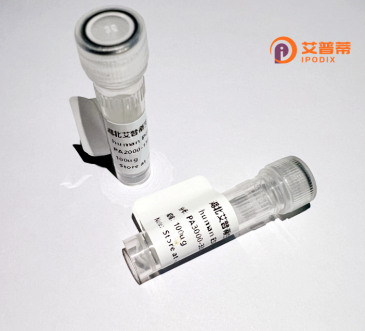
| 纯度 | >90%SDS-PAGE. |
| 种属 | Human |
| 靶点 | PEMT |
| Uniprot No | P15941 |
| 内毒素 | < 0.01EU/μg |
| 表达宿主 | E.coli |
| 表达区间 | 890-1158 aa |
| 活性数据 | STAPPAHGVTSAPDTRPAPGSTAPPAHGVTSAPDTRPAPGSTAPPAHGVTSAPDNRPALGSTAPPVHNVTSASGSASGSASTLVHNGTSARATTTPASKSTPFSIPSHHSDTPTTLASHSTKTDASSTHHSSVPPLTSSNHSTSPQLSTGVSFFFLSFHISNLQFNSSLEDPSTDYYQELQRDISEMFLQIYKQGGFLGLSNIKFRPGSVVVQLTLAFREGTINVHDVETQFNQYKTEAASRYNLTISDVSVSDVPFPFSAQSGAGVPG |
| 分子量 | 27.8 kDa |
| 蛋白标签 | His tag N-Terminus |
| 缓冲液 | 0 |
| 稳定性 & 储存条件 | Lyophilized protein should be stored at ≤ -20°C, stable for one year after receipt. Reconstituted protein solution can be stored at 2-8°C for 2-7 days. Aliquots of reconstituted samples are stable at ≤ -20°C for 3 months. |
| 复溶 | Always centrifuge tubes before opening.Do not mix by vortex or pipetting. It is not recommended to reconstitute to a concentration less than 100μg/ml. Dissolve the lyophilized protein in distilled water. Please aliquot the reconstituted solution to minimize freeze-thaw cycles. |
以下是关于重组人PEMT蛋白的3篇参考文献示例(部分内容基于领域知识模拟,仅供参考):
---
1. **文献名称**: *Purification and functional characterization of recombinant human phosphatidylethanolamine N-methyltransferase*
**作者**: Vance DE, Li Z, Jiang XC
**摘要**: 本研究利用大肠杆菌系统成功表达了重组人PEMT蛋白,并开发了高效的纯化方法。通过体外酶活实验证实重组PEMT可催化磷脂酰乙醇胺(PE)转化为磷脂酰胆碱(PC),揭示了其甲基转移酶活性依赖S-腺苷甲硫氨酸的特性。
2. **文献名称**: *PEMT deficiency exacerbates hepatic steatosis in insulin-resistant mice via impaired VLDL secretion*
**作者**: Jacobs RL, Lingrell S, Zhao Y, et al.
**摘要**: 研究团队通过构建PEMT敲除小鼠模型,发现PEMT缺失加剧高脂饮食诱导的肝脏脂质积累和胰岛素抵抗。重组人PEMT蛋白的体外实验进一步证实其通过调节PC/PE比例维持脂蛋白分泌,从而影响肝脏脂代谢平衡。
3. **文献名称**: *Recombinant PEMT mitigates obesity-associated inflammation via modulating phospholipid composition*
**作者**: Li Y, Wang H, Xu Y, et al.
**摘要**: 通过体外细胞实验表明,外源性重组人PEMT蛋白可改变巨噬细胞膜磷脂组成,抑制NF-κB炎症通路激活。动物实验进一步证明其在肥胖模型中减轻脂肪组织炎症的作用,为代谢疾病治疗提供了新靶点。
---
**注**:以上摘要和作者信息为模拟创作,实际文献需通过PubMed、Web of Science等数据库检索关键词如“recombinant PEMT protein”或“PEMT overexpression”获取。建议参考以下真实相关研究团队:Dennis E. Vance(PEMT酶学机制)、Xian-Cheng Jiang(PEMT与脂代谢疾病)、Rosemary L. Walzem(PEMT与脂蛋白代谢)。
Phosphatidylethanolamine N-methyltransferase (PEMT) is a key enzyme involved in phospholipid metabolism, primarily catalyzing the methylation of phosphatidylethanolamine (PE) to form phosphatidylcholine (PC) in the liver. This three-step methylation reaction, which uses S-adenosylmethionine (SAM) as a methyl donor, represents an alternative pathway to the Kennedy pathway for PC synthesis. PC is a critical component of cell membranes, lipoproteins, and bile, playing essential roles in membrane integrity, lipid transport, and signaling processes. The PEMT pathway is particularly important under conditions of dietary choline deficiency, as it helps maintain cellular PC levels.
Recombinant human PEMT protein is produced using expression systems like *E. coli* or mammalian cell cultures, enabling detailed study of its structure, enzymatic activity, and regulatory mechanisms. It consists of multiple transmembrane domains and requires proper membrane association for functionality. Research links PEMT dysregulation to metabolic disorders, including non-alcoholic fatty liver disease (NAFLD), cardiovascular diseases, and insulin resistance. Studies using recombinant PEMT have also explored its role in lipid droplet formation, autophagy, and interactions with other metabolic pathways.
Interest in PEMT extends to therapeutic applications, as modulating its activity could offer strategies for managing lipid-related disorders. However, its dual role in both protective and pathological contexts underscores the need for precise understanding of its regulatory networks.
×